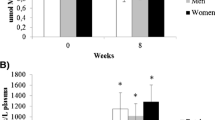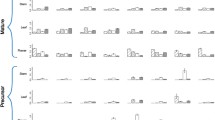Abstract
Background
Epidemiological studies indicate that consumption of cruciferous vegetables (CV) can reduce the risk of cancer. Supposed mechanisms are partly the inhibition of phase I and the induction of phase II enzymes.
Aim
The aim of this study was to investigate in vitro and in vivo effects of watercress (WC), a member of the CV family, on chemopreventive parameters using human peripheral blood mononuclear cells (PBMC) as surrogate cells. We investigated the hypothesis that WC reduces cancer risk by inducing detoxification enzymes in a genotype-dependent manner.
Methods
In vitro gene expression and enzyme activity experiments used PBMC incubated with a crude extract from fresh watercress (WCE, 0.1–10 μL/mL with 8.2 g WC per 1 mL extract) or with one main key compound phenethyl isothiocyanate (PEITC, 1–10 μM). From an in vivo perspective, gene expression and glutathione S-transferase (GST) polymorphisms were determined in PBMC obtained from a human intervention study in which subjects consumed 85 g WC per day for 8 weeks. The influence of WC consumption on gene expression was determined for detoxification enzymes such as superoxide dismutase 2 (SOD2) and glutathione peroxidase 1 (GPX1), whilst the SOD and GPX activities in red blood cells were also analysed with respect to GST genotypes.
Results
In vitro exposure of PBMC to WCE or PEITC (24 h) increased gene expression for both detoxification enzymes GPX1 (5.5-fold, 1 μL/mL WCE, 3.7-fold 1 μM PEITC) and SOD2 (12.1-fold, 10 μL/mL WCE, 7.3-fold, 10 μM PEITC), and increased SOD2 activity (1.9-fold, 10 μL/mL WCE). The WC intervention had no significant effect on in vivo PBMC gene expression, as high individual variations were observed. However, a small but significant increase in GPX (p = 0.025) and SOD enzyme activity (p = 0.054) in red blood cells was observed in GSTM1*0, but not in GSTM1*1 individuals, whilst the GSTT1 genotype had no impact.
Conclusion
The results indicate that WC is able to modulate the enzymes SOD and GPX in blood cells in vitro and in vivo, and suggest that the capacity of moderate intake of CV to induce detoxification is dependent in part on the GSTM1 genotype.




Similar content being viewed by others
References
Behrend L, Henderson G, Zwacka RM (2003) Reactive oxygen species in oncogenic transformation. Biochem Soc Trans 31:1441–1444
Bell DA, Taylor JA, Paulson DF, Robertson CN, Mohler JL, Lucier GW (1993) Genetic risk and carcinogen exposure: a common inherited defect of the carcinogen-metabolism gene glutathione S-transferase M1 (GSTM1) that increases susceptibility to bladder cancer. J Natl Cancer Inst 85:1159–1164
Boyd LA, McCann MJ, Hashim Y, Bennett RN, Gill CI, Rowland IR (2006) Assessment of the anti-genotoxic, anti-proliferative, and anti-metastatic potential of crude watercress extract in human colon cancer cells. Nutr Cancer 55:232–241
Bradford MM (1976) A rapid and sensitive method for the quantification of microgram quantities of protein utilizing the principle of protein–dye binding. Anal Biochem 72:248–254
Branca F, Hanley AB, Pool-Zobel BL, Verhagen H (2001) Biomarkers in disease and health. Br J Nutr 86:S55–S92
Brennan P, Hsu CC, Moullan N, Szeszenia-Dabrowska N, Lissowska J, Zaridze D, Rudnai P, Fabianova E, Mates D, Bencko V, Foretova L, Janout V, Gemignani F, Chabrier A, Hall J, Hung RJ, Boffetta P, Canzian F (2005) Effect of cruciferous vegetables on lung cancer in patients stratified by genetic status: a Mendelian randomisation approach. Lancet 366:1558–1560
Buettner GR, Ng CF, Wang M, Rodgers VG, Schafer FQ (2006) A new paradigm: manganese superoxide dismutase influences the production of H2O2 in cells and thereby their biological state. Free Radic Biol Med 41:1338–1350
Canistro D, Croce CD, Iori R, Barillari J, Bronzetti G, Poi G, Cini M, Caltavuturo L, Perocco P, Paolini M (2004) Genetic and metabolic effects of gluconasturtiin, a glucosinolate derived from Cruciferae. Mutat Res 545:23–35
Chung FL, Morse MA, Eklind KI, Lewis J (1992) Quantitation of human uptake of the anticarcinogen phenethyl isothiocyanate after a watercress meal. Cancer Epidemiol Biomarkers Prev 1:383–388
Gill CI, Haldar S, Boyd LA, Bennett R, Whiteford J, Butler M, Pearson JR, Bradbury I, Rowland IR (2007) Watercress supplementation in diet reduces lymphocyte DNA damage and alters blood antioxidant status in healthy adults. Am J Clin Nutr 85:504–510
Giovannucci E, Rimm EB, Liu Y, Stampfer MJ, Willett WC (2003) A prospective study of cruciferous vegetables and prostate cancer. Cancer Epidemiol Biomarkers Prev 12:1403–1409
Glei M, Liegibel UM, Ebert MN, Böhm V, Pool-Zobel BL (2002) ß-Carotene reduces bleomycin-induced genetic damage in human lymphocytes. Toxicol Appl Pharmacol 179:65–73
Gomi F, Matsuo M (2002) Effects of 60% oxygen inhalation on the survival and antioxidant enzyme activities of young and old rats. Mech Ageing Dev 123:1295–1304
Guo Z, Smith TJ, Wang E, Sadrieh N, Ma Q, Thomas PE, Yang CS (1992) Effects of phenethyl isothiocyanate, a carcinogenesis inhibitor, on xenobiotic-metabolizing enzymes and nitrosamine metabolism in rats. Carcinogenesis 13:2205–2210
Haristoy X, Fahey JW, Scholtus I, Lozniewski A (2005) Evaluation of the antimicrobial effects of several isothiocyanates on Helicobacter pylori. Planta Med 71:326–330
Hayes JD, Kelleher MO, Eggleston IM (2008) The cancer chemopreventive actions of phytochemicals derived from glucosinolates. Eur J Nutr 47(suppl 2):73–88
Hecht SS, Carmella SG, Murphy SE (1999) Effects of watercress consumption on urinary metabolites of nicotine in smokers. Cancer Epidemiol Biomarkers Prev 8:907–913
Hecht SS, Chung FL, Richie JP Jr, Akerkar SA, Borukhova A, Skowronski L, Carmella SG (1995) Effects of watercress consumption on metabolism of a tobacco-specific lung carcinogen in smokers. Cancer Epidemiol Biomarkers Prev 4:877–884
Heiss E, Herhaus C, Klimo K, Bartsch H, Gerhauser C (2001) Nuclear factor kappa B is a molecular target for sulforaphane-mediated anti-inflammatory mechanisms. J Biol Chem 276:32008–32015
Higdon JV, Delage B, Williams DE, Dashwood RH (2007) Cruciferous vegetables and human cancer risk: epidemiologic evidence and mechanistic basis. Pharmacol Res 55:224–236
Kassie F, Laky B, Gminski R, Mersch-Sundermann V, Scharf G, Lhoste E, Kansmuller S (2003) Effects of garden and water cress juices and their constituents, benzyl and phenethyl isothiocyanates, towards benzo(a)pyrene-induced DNA damage: a model study with the single cell gel electrophoresis/Hep G2 assay. Chem Biol Interact 142:285–296
Keck AS, Finley JW (2004) Cruciferous vegetables: cancer protective mechanisms of glucosinolate hydrolysis products and selenium. Integr Cancer Ther 3:5–12
Lampe JW, Chen C, Li S, Prunty J, Grate MT, Meehan DE, Barale KV, Da Dightman, Feng ZPJD (2000) Modulation of human glutathione S-transferases by botanically defined vegetable diets. Cancer Epidemiol Biomarkers Prev 9:787–793
Lampe JW, Peterson S (2002) Brassica, biotransformation and cancer risk: genetic polymorphisms alter the preventive effects of cruciferous vegetables. J Nutr 132:2991–2994
London SJ, Yuan JM, Chung FL, Gao YT, Coetzee GA, Ross RK, Yu MC (2000) Isothiocyanates, glutathione S-transferase M1 and T1 polymorphisms, and lung-cancer risk: a prospective study of men in Shanghai, China. Lancet 356:724–729
Mates JM, Perez-Gomez C, Nunez de Castro I (1999) Antioxidant enzymes and human diseases. Clin Biochem 32:595–603
Niu CS, Chang CK, Lin LS, Jou SB, Kuo DH, Liao SS, Cheng JT (1998) Modification of superoxide dismutase (SOD) mRNA and activity by a transient hypoxic stress in cultured glial cells. Neurosci Lett 251:145–148
Palaniswamy UR, McAvoy RJ, Bible BB, Stuart JD (2003) Ontogenic variations of ascorbic acid and phenethyl isothiocyanate concentrations in watercress (Nasturtium officinale R.Br.) leaves. J Agric Food Chem 51:5504–5509
Pemble S, Schroeder KR, Spencer SR, Meyer DJ, Hallier E, Bolt HM, Ketterer B, Taylor JB (1994) Human glutathione S-transferase theta (GSTT1): cDNA cloning and the characterization of a genetic polymorphism. Biochem J 300:271–276
Pfaffl MW (2001) A new mathematical model for relative quantification in real-time RT-PCR. Nucleic Acids Res 29:e45
Pfaffl MW, Horgan GW, Dempfle L (2002) Relative expression software tool (REST) for group-wise comparison and statistical analysis of relative expression results in real-time PCR. Nucleic Acids Res 30:e36
Pool-Zobel B, Veeriah S, Bohmer FD (2005) Modulation of xenobiotic metabolising enzymes by anticarcinogens: focus on glutathione S-transferases and their role as targets of dietary chemoprevention in colorectal carcinogenesis 1. Mutat Res 591:74–92
Pullar JM, Thomson SJ, King MJ, Turnbull CI, Midwinter RG, Hampton MB (2004) The chemopreventive agent phenethyl isothiocyanate sensitizes cells to Fas-mediated apoptosis. Carcinogenesis 25:765–772
Rockett JC, Burczynski ME, Fornace AJ, Herrmann PC, Krawetz SA, Dix DJ (2004) Surrogate tissue analysis: monitoring toxicant exposure and health status of inaccessible tissues through the analysis of accessible tissues and cells. Toxicol Appl Pharmacol 194:189–199
Rose P, Faulkner K, Williamson G, Mithen R (2000) 7-Methylsulfinylheptyl and 8-methylsulfinyloctyl isothiocyanates from watercress are potent inducers of phase II enzymes. Carcinogenesis 21:1983–1988
Seow A, Yuan JM, Sun CL, Van Den Berg D, Lee HP, Yu MC (2002) Dietary isothiocyanates, glutathione S-transferase polymorphisms and colorectal cancer risk in the Singapore Chinese Health Study. Carcinogenesis 23:2055–2061
Spitz MR, Duphorne CM, Detry MA, Pillow PC, Amos CI, Lei L, Andrade M, Gu X, Hong WK, Wu X (2000) Dietary intake of isothiocyanates: evidence of a joint effect with glutathione S-transferase polymorphisms in lung cancer risk. Cancer Epidemiol Biomarkers Prev 9:1017–1020
St Clair D (2004) Manganese superoxide dismutase: genetic variation and regulation. J Nutr 134:3190S–3191S
St Clair DK, Holland JC (1991) Complementary DNA encoding human colon cancer manganese superoxide dismutase and the expression of its gene in human cells. Cancer Res 51:939–943
Talalay P, Fahey JW (2001) Phytochemicals from cruciferous plants protect against cancer by modulating carcinogen metabolism. J Nutr 131:3027S–3033S
Traka M, Gasper AV, Melchini A, Bacon JR, Needs PW, Frost V, Chantry A, Jones AM, Ortori CA, Barrett DA, Ball RY, Mills RD, Mithen RF (2008) Broccoli consumption interacts with GSTM1 to perturb oncogenic signalling pathways in the prostate. PLoS ONE 3:e2568
Valko M, Rhodes CJ, Moncol J, Izakovic M, Mazur M (2006) Free radicals, metals and antioxidants in oxidative stress-induced cancer. Chem Biol Interact 160:1–40
van Lieshout EMM, Peters WHM, Jansen JB (1996) Effect of oltipraz, alpha-tocopherol, betacarotene and phenethylisothiocyanate on rat oesophageal, gastric, colonic and hepatic glutathone, glutathione S-transferase and peroxidase. Carcinogenesis 17:1439–1445
van Poppel G, Verhoeven DT, Verhagen H, Goldbohm RA (1999) Brassica vegetables and cancer prevention. Epidemiology and mechanisms. Adv Exp Med Biol 472:159–168
Visanji JM, Duthie SJ, Pirie L, Thompson DG, Padfield PJ (2004) Dietary isothiocyanates inhibit Caco-2 cell proliferation and induce G2/M phase cell cycle arrest, DNA damage, and G2/M checkpoint activation. J Nutr 134:3121–3126
Wang LI, Giovannucci EL, Hunter D, Neuberg D, Su L, Christiani DC (2004) Dietary intake of cruciferous vegetables, Glutathione S-transferase (GST) polymorphisms and lung cancer risk in a Caucasian population. Cancer Causes Control 15:977–985
Xu Y, Krishnan A, Wan XS, Majima H, Yeh CC, Ludewig G, Kasarskis EJ, St Clair DK (1999) Mutations in the promoter reveal a cause for the reduced expression of the human manganese superoxide dismutase gene in cancer cells. Oncogene 18:93–102
Xu Y, Porntadavity S, St Clair DK (2002) Transcriptional regulation of the human manganese superoxide dismutase gene: the role of specificity protein 1 (Sp1) and activating protein-2 (AP-2). Biochem J 362:401–412
Yazdanparast R, Bahramikia S, Ardestani A (2008) Nasturtium officinale reduces oxidative stress and enhances antioxidant capacity in hypercholesterolaemic rats. Chem Biol Interact 172:176–184
Zhang SM, Hunter DJ, Rosner BA, Giovannucci EL, Colditz GA, Speizer FE, Willett WC (2000) Intakes of fruits, vegetables, and related nutrients and the risk of non-Hodgkin’s lymphoma among women. Cancer Epidemiol Biomarkers Prev 9:477–485
Zhao B, Seow A, Lee EJ, Poh WT, Teh M, Eng P, Wang YT, Tan WC, Yu MC, Lee HP (2001) Dietary isothiocyanates, glutathione S-transferase-M1, -T1 polymorphisms and lung cancer risk among Chinese women in Singapore. Cancer Epidemiol Biomarkers Prev 10:1063–1067
Acknowledgments
The watercress intervention study was supported by Vitacress Ltd, Geest Plc, and the Watercress Company.
Author information
Authors and Affiliations
Corresponding author
Rights and permissions
About this article
Cite this article
Hofmann, T., Kuhnert, A., Schubert, A. et al. Modulation of detoxification enzymes by watercress: in vitro and in vivo investigations in human peripheral blood cells. Eur J Nutr 48, 483–491 (2009). https://doi.org/10.1007/s00394-009-0039-5
Received:
Accepted:
Published:
Issue Date:
DOI: https://doi.org/10.1007/s00394-009-0039-5




